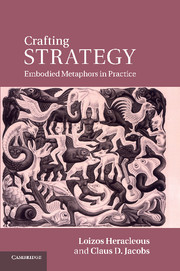Book contents
- Frontmatter
- Contents
- List of figures
- List of tables
- Preface
- Acknowledgments
- Vignette A BASF PerForm
- Vignette B UNICEF
- 2 Metaphor and embodied realism
- 3 Analyzing embodied metaphors as an interpretive, hermeneutic endeavor
- Vignette C Project Voltigo
- Vignette D Hephata Foundation
- Vignette E Privatbank IHAG Zürich AG
- Vignette F World Vision New Zealand
- Glossary
- Index
- References
2 - Metaphor and embodied realism
Published online by Cambridge University Press: 05 June 2011
- Frontmatter
- Contents
- List of figures
- List of tables
- Preface
- Acknowledgments
- Vignette A BASF PerForm
- Vignette B UNICEF
- 2 Metaphor and embodied realism
- 3 Analyzing embodied metaphors as an interpretive, hermeneutic endeavor
- Vignette C Project Voltigo
- Vignette D Hephata Foundation
- Vignette E Privatbank IHAG Zürich AG
- Vignette F World Vision New Zealand
- Glossary
- Index
- References
Summary
In this chapter we outline the key theoretical antecedents to crafting strategy through embodied metaphors, primarily in terms of two domains: metaphor and embodied realism. In particular, we discuss metaphor as a creative force, beginning from the cognitive/semantic dimension, moving to the spatial, and then the embodied dimension. Further, given that crafting strategy through embodied metaphors has in practice taken place in the context of organization development interventions, we discuss the theoretical development of metaphor in this context. We finally address the paradigm of embodied realism in relation to social constructionism, so that embodied realism can be more specifically positioned. These theoretical antecedents will form the backdrop for subsequent discussion in subsequent chapters, for example of the concept of crafting strategy as a practice of recursive embodied enactment, in Chapter 4.
Metaphor as a creative force
The linguistic turn in the social sciences has portrayed language as fundamentally constructive and constitutive of social reality, rather than merely representative and functional (Wittgenstein, 1967). In organization studies, the constructive view of language thus seeks to explore the communicative practices of organizational actors and their role in the intersubjective construction of meaning through social interaction (e.g. Alvesson and Karreman, 2000; Barry and Elmes, 1997; Ford and Ford, 1995; Gergen and Thatchenkery, 1996; Heracleous and Barrett, 2001).
- Type
- Chapter
- Information
- Crafting StrategyEmbodied Metaphors in Practice, pp. 21 - 41Publisher: Cambridge University PressPrint publication year: 2011



